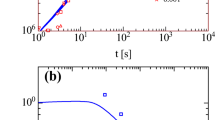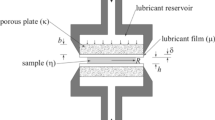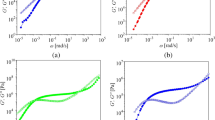Abstract
In a Rheotens experiment, the tensile force needed for elongation of an extruded filament is measured as a function of the draw ratio. For thermo-rheologically simple polymer melts, the existence of Rheotens-mastercurves was proved by Wagner, Schulze, and Göttfert (1995). Rheotens-mastercurves are invariant with respect to changes in melt temperature and changes in the average molar mass. By use of purely viscous models, we convert Rheotens-mastercurves of a branched and a linear polyethylene melt to elongational viscosity as a function of strain rate. The resulting elongational viscosity from constant force extension experiments is found to be in general agreement with what is expected as steady-state viscosity of polyethylene melts measured in either constant strain-rate or constant stress mode.
Similar content being viewed by others
References
Bayer RK, Schreiner H, Ruland W (1978) Tensile properties of an extruded polyethylen melt. Rheol Acta 17:28–32
Bayer RK (1979) The force-strain relation of extruded polyethylene melt. Rheol Acta 18:25–32
Denn MM (1980) Continuous drawing of liquids to form fibers. Ann Rev Fluid Mech 12:365–387
Ghijsels A, Ente JJSM, Raadsen J (1990) Melt strength behavior of PE and its relation to bubble stability in film blowing. IPP 5:284–286
Ghijsels A, Ente JJSM, Raadsen J (1992) Melt strength behavior of polyethylene blends. IPP 7:44–50
Ghijsels A, De Clippeleir J (1994) Melt strength behaviour of polypropylenes. IPP 9:252–257
Hyun JC, Ballman RL (1978) Isothermal melt spinning - Lagrangian and Eulerian viewpoints. J Rheol 22:349–380
Laun HM, Münstedt H (1978) Elongational behaviour of a low density polyethylene melt. Rheol Acta 17:415–425
Laun HM (1987) Orientation of macromolecules and elastic deformations in polymer melts. Influence of molecular structure on the reptation of molecules. Progr Colloid & Polymer Sci 75: 111–139
Laun HM, Schuch H (1989) Transient elongational viscosities and drawability of polymer melts. J Rheol 33:119–175
La Mantia FP, Acierno D (1985) Influence of molecular structure on the melt strength and extensibility of polyethylenes. Polym Eng Sci 25:279–283
Meissner J (1963) The effect of temperature on the flow properties of the low density polyethylen melt. Proceedings 4th Int, Congress Rheoly, Providence, Part 3:437–453
Meissner J (1969) Anordnung zum Bestimmen des deformationsmechanischen Verhaltens von teigigen Stoffen, Pasten und Schmelzen. DOS 1904079
Meissner J (1971) Dehnungsverhalten von Polyäthylen-Schmelzen. Rheol Acta 10:230–242
Meissner J (1975) Basic parameters, melt theology, processing and end-use properties of three similar low density polyethylene samples. Pure Appl Chem 42:553–612
Münstedt H, Laun HM (1981) Elongational properties and molecular structure of polyethylene melts. Rheol Acta 20: 211–221
Raible T, Stephenson SE, Meissner J, Wagner MH (1982) Constant force elongational flow of a low-density polyethylene melt — experiment and theory. J Non-Newtonian Fluid Mech 11:239–256
Schwarzl FR (1990) Polymermechanik, Berlin Heidelberg
Wagner MH (1979a) Zur Netzwerktheorie von Polymer-Schmelzen. Rheol Acta 18:33–50
Wagner MH (1979b) Elongational behaviour of polymer melts in constant elongation-rate, constant tensile stress, and constant force extension experiments. Rheol Acta 18:681–692
Wagner MH, Demarmels A (1990) A constitutive analysis of extensional flows of polyisobutylene. J Rheol 34:943–957
Wagner MH, Schulze V, Göttfert A (1995) Rheotens-mastercurves and drawability of polymer melts. Accepted J Polym Sci
White JL, Yamane H (1987) A collaborative study of the stability of extrusion, melt spinning and tubular film extrusion of some high-, low- and linear-low density polyethylene samples. Pure Appl Chem 59:193–216
Wolff R (1986) Untersuchung des Rheotensversuchs hinsichtlich seiner Eignung als Wareneingangskontrollverfahren. Poly Proc Eng 4:97–123
Wolff R (1990) Der Rheotensversuch als Wareneingangskontrollverfahren. Ph D thesis, Stuttgart University
Author information
Authors and Affiliations
Additional information
Dedicated to Prof. Dr. J. Meissner on the occasion of his retirement from the chair of Polymer Physics at the Eidgenössische Technische Hochschule (ETH) Zürich, Switzerland
Rights and permissions
About this article
Cite this article
Wagner, M.H., Collignon, B. & Verbeke, J. Rheotens-mastercurves and elongational viscosity of polymer melts. Rheol Acta 35, 117–126 (1996). https://doi.org/10.1007/BF00396038
Received:
Accepted:
Issue Date:
DOI: https://doi.org/10.1007/BF00396038




